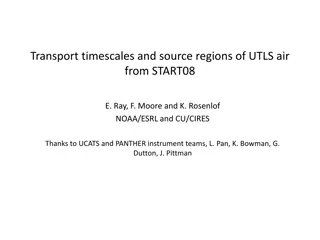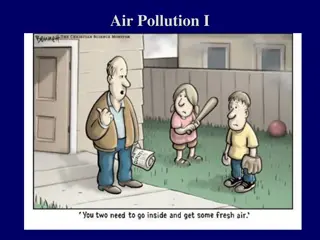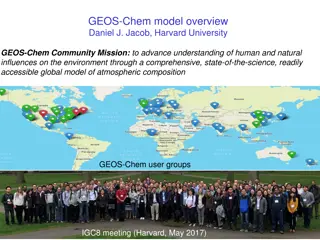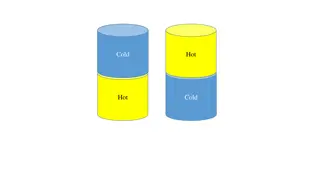Sullivan Environmental Leaders in Air Quality Consulting
Sullivan Environmental provides expert air quality litigation support services, leveraging decades of experience and comprehensive expertise in atmospheric air quality modeling and monitoring. Our certified consulting meteorologists offer authoritative analysis and testimony, assisting clients in le
3 views • 6 slides
Understanding Atmosphere Composition and Structure in Climatology
The study of climatology, focusing on the atmosphere, is presented by Dr. Banashree Saikia, covering topics such as atmospheric composition, insolation, temperature variations, atmospheric pressure, wind systems, atmospheric moisture, climatic classification, cyclones, and monsoons. The atmosphere,
1 views • 9 slides
Understanding Basic Meteorology Concepts for Air Quality Management
Pollutants circulate in the troposphere following air movement patterns around low-pressure fronts and high-pressure systems. Anticyclones and cyclones play a crucial role in atmospheric stability and pollutant dispersion. The relationship between lapse rates determines air stability and pollutant d
0 views • 24 slides
Understanding Geopotential and Geopotential Height in Atmospheric Thermodynamics
Explore the concept of geopotential and geopotential height in atmospheric sciences, focusing on their significance in understanding gravitational and centrifugal forces on Earth. Learn about the definition, calculation, and applications of geopotential height in relation to atmospheric properties a
1 views • 14 slides
Understanding Atmospheric Moisture in Physical Geography
Atmospheric moisture, in the form of water vapor, liquid water, and ice, plays a crucial role in shaping weather and climate. This course delves into the dynamics of atmospheric moisture, including its distribution, effects on weather patterns, and impact on various climatic factors such as precipit
0 views • 7 slides
Understanding Environmental Hygiene: Air Pollution and Composition of Air
The content delves into the concept of atmospheric pollution, the composition of pure and impure air, sources of air pollution, and the zones of the atmosphere. It highlights the detrimental effects of pollutants on health and the environment, emphasizing the importance of environmental hygiene. The
1 views • 27 slides
Understanding Air Masses and Fronts in Weather Systems
Explore the concept of air masses, their characteristics, source regions, classification, and global distribution. Learn how air masses and fronts influence weather systems, affecting temperature, moisture, and atmospheric pressure. Gain insights into the different types of air masses in North Ameri
0 views • 27 slides
Understanding Atmospheric Thickness and Its Applications
Atmospheric thickness refers to the difference in geopotential height between two pressure surfaces, which is dependent on the mean virtual temperature of the layer in between. This concept plays a key role in determining temperature gradients, identifying fronts, and aiding in weather forecasting,
0 views • 11 slides
Understanding Synoptic Meteorology: A Comprehensive Overview
Synoptic meteorology delves into various aspects of atmospheric sciences, encompassing scales of atmospheric motion, weather maps, air masses, fronts, jet streams, and more. Through the study of synoptic meteorology, meteorologists gain insights into interpreting the state of the troposphere and for
1 views • 17 slides
Understanding Air Pollution and Its Impact on Health and Environment
Air pollution poses a significant threat to human health, the environment, and the economy. The Clean Air Act has played a crucial role in reducing air pollutants since its establishment in 1963. Criteria air pollutants such as ozone, particle pollution, carbon monoxide, lead, sulfur dioxide, and ni
1 views • 11 slides
Air Quality Management Division Overview
The Air Quality Management Division in Reno, Sparks, and Washoe County focuses on implementing clean air solutions through community partnerships and various programs and services such as air monitoring, permitting, compliance, planning, and public education. The division ensures compliance with amb
0 views • 8 slides
Understanding Atmospheric Pressure Variations at Different Altitudes
Atmospheric pressure varies with altitude due to the weight of the air column above. This activity explores how Otto von Guericke's experiments with vacuum systems demonstrate the power of air pressure. Theoretical concepts of atmospheric pressure are discussed, highlighting its relation to gravity
0 views • 28 slides
Cutting-Edge Atmospheric Chemistry Modeling Research at Barcelona Supercomputing Center
Conducted by the Atmospheric Composition Group at Barcelona Supercomputing Center, this cutting-edge research focuses on atmospheric chemistry modeling using advanced tools and frameworks like HERMESv3 and MONARCH. The team's approach integrates various modules to study complex processes influencing
0 views • 16 slides
Understanding Fluid Statics and Atmospheric Pressure Measurements
Exploring the concept of fluid statics, this content delves into topics such as how atmospheric pressure is measured, buoyancy, and why a steel boat can float. It covers the measurement of pressure, the relationship between pressure and depth in fluids, and demonstrations showcasing these principles
0 views • 24 slides
Overview of Low-Cost Sensors for Atmospheric Composition Measurement
This publication provides an insightful overview of low-cost sensors for measuring atmospheric composition, covering topics like sensor technologies, applications in atmospheric sciences and air quality management, and evaluation methods. It emphasizes the importance of not only the technical perfor
0 views • 17 slides
Understanding Atmospheric Circulation and Wind Patterns
Learn about atmospheric circulation, local winds, terrain types, mean velocity profiles, and different types of winds such as prevailing winds, periodic winds, and local winds. Explore the concept of planetary winds like Trade Winds and Westerly Winds, and understand how winds create air currents. D
0 views • 22 slides
Understanding Atmospheric Circulation on Earth
An atmospheric circulation driven by temperature differences between the equator and poles influences global weather patterns. The sun's changing angle throughout the year results in various pressure areas and the formation of large circulation cells. The main effects include the transport of humidi
0 views • 11 slides
Understanding Large-Scale Winds and Atmospheric Circulation
Large-scale prevailing winds, such as the Hadley Cell, vary by latitude. These winds drive global atmospheric circulation, with rising air at the equator, sinking air at 30 degrees, and trade winds in between. By studying wind patterns, we gain insights into climate systems and weather phenomena.
0 views • 13 slides
Understanding Atmospheric Boundary Layer and Static Stability
The Atmospheric Boundary Layer (ABL) undergoes daily variations in temperature, humidity, wind, and pollution with turbulence being a key factor. Static stability in the environment determines the behavior of air parcels, leading to categorizations of stable, unstable, and neutral conditions based o
0 views • 13 slides
Introduction to Environmental Thermal Engineering: Air Conditioning Systems and HVAC Applications
This lecture covers the fundamentals of air conditioning systems, including the equipment, HVAC systems, and applications. It explains the concept of air conditioning, its processes, and its significance in controlling temperature, humidity, cleanliness, and air distribution for occupant comfort. Ad
0 views • 85 slides
Understanding Transport Timescales and Source Regions of UTLS Air
Complex mixtures of air in the Upper Troposphere and Lower Stratosphere (UTLS) are studied using in situ trace gas measurements from the START08 campaign and surface stations. This research aims to determine transport timescales and source regions of air in the extratropical UTLS, focusing on high a
0 views • 11 slides
Understanding the Basics of Air Conditioning and HVAC Systems
Introduction to the Heating, Ventilation, and Air Conditioning (HVAC) system along with the key components and functions involved in maintaining indoor comfort levels such as temperature, humidity, air quality, and air movement. Explains the importance of controlling the atmospheric environment for
0 views • 24 slides
Understanding the Planetary Boundary Layer in Atmospheric Science
The Planetary Boundary Layer (PBL) plays a crucial role in atmospheric dynamics, divided into surface, mixed, stable, and residual layers. During the day, the mixed layer experiences convective motions due to surface heating, while the stable layer dominates during the night. Understanding these lay
0 views • 18 slides
Understanding Inequity in Air Quality: Implications for Climate and Human Health
This course delves into the chemical and physical processes governing atmospheric composition and their impact on climate, ecosystems, and human welfare. Students explore topics such as nitrogen, oxygen, carbon, and sulfur cycles, as well as the chemical forcing of climate change. The course highlig
0 views • 6 slides
NSF Atmospheric Chemistry Program Overview
The NSF Atmospheric Chemistry Program aims to characterize the chemical composition of the atmosphere, understand chemical processes, quantify fluxes of chemical substances, study natural and anthropogenic causes of variability, and assess impacts on climate. The program supports research through pe
0 views • 6 slides
Understanding Atmospheric Chemistry Measurements and Methods
Explore the various types of atmospheric chemistry measurements, including research vs. monitoring, gas phase species, satellite vs. in situ observations, and spectroscopy and chromatography methods. Discover how researchers and regulatory bodies use different techniques to study and monitor air qua
0 views • 34 slides
Understanding Atmospheric Thermodynamics in Meteorology
Explore the fundamentals of atmospheric thermodynamics including dry air properties, dry adiabatic lapse rate, moist air components, and saturated adiabatic lapse rate. Delve into concepts like dew point temperature, relative humidity, and wet bulb temperature to gain insight into air behavior in va
0 views • 22 slides
Understanding Atmospheric Composition and Structure
The presentation covers fundamental concepts related to the Earth's atmosphere, including its composition, origin of oxygen, dry and moist layers, standard atmosphere layers, and temperature variations. Key topics discussed include the primordial atmosphere, atmospheric constituents, water vapor dis
0 views • 58 slides
Understanding Atmospheric Thermodynamics and Humidity Measurements
Explore the key concepts of atmospheric thermodynamics including wet bulb temperature, wet bulb depression, dew-point temperature, and relative humidity. Learn how meteorologists use psychrometric charts to measure humidity and analyze air moisture content. Discover the significance of wet bulb depr
0 views • 20 slides
Understanding Atmospheric Thermodynamics and Environmental Lapse Rate
Explore the concepts of atmospheric thermodynamics including the Parcel Method, Environmental Lapse Rate, and Conditionally Unstable Atmosphere. Dive into the details of how air parcels behave in different atmospheric conditions and understand the significance of temperature changes in the atmospher
0 views • 27 slides
Historical Overview of Air Pollution: From London Smog to Modern Sources
Explore the history of catastrophic air pollution events dating back to 1911 in London, highlighting the impacts on public health. Learn about the major classes of air pollutants, their sources, and effects, along with key test questions related to air quality and pollution control measures. Delve i
0 views • 32 slides
GEOS-Chem Atmospheric Chemistry Model Overview
GEOS-Chem, developed by Daniel J. Jacob at Harvard University, is a global model of atmospheric composition used to understand human and natural influences on the environment. The model addresses various atmospheric chemistry issues on different scales, from local to global, and is regularly updated
0 views • 19 slides
Understanding Atmospheric Stability and Adiabatic Processes
Atmospheric stability is crucial in determining weather conditions. Different processes such as adiabatic cooling play a significant role in the vertical movement of air masses. Understanding the environmental lapse rate, moist and dry adiabatic rates, and the concept of conditional instability help
0 views • 4 slides
Understanding Atmospheric Pressure, Wind Variations, and Humidity in Weather Systems
The atmosphere is composed of various elements like gaseous molecules, water vapor, and dust particles. Key weather variables include atmospheric pressure, temperature, humidity, wind, cloud cover, and precipitation. Atmospheric pressure is influenced by the weight of air above a point, with average
0 views • 17 slides
Understanding Atmospheric Inversions and Air Quality Impact
Explore the effects of atmospheric inversions on air quality, particularly during wildland fires. Learn about stable and unstable air conditions, how pollutants behave in different scenarios, and where they disperse. Discover the impact of temperature inversions on smoke movement and the importance
0 views • 6 slides
Understanding Air Masses in Synoptic Meteorology
Air masses are large bodies of air with uniform temperature and moisture conditions, influencing weather patterns across vast regions. Source regions play a key role in determining the characteristics of air masses, with factors such as stability of atmospheric circulation and surface properties sha
0 views • 17 slides
The DC and AC global atmospheric electric circuits as central tenets in Earth system science today
The presentation at the EGU General Assembly highlighted the significance of DC and AC global atmospheric electric circuits in Earth system science. Key references from 2007 to 2018 underscore the evolving research in this field, exploring the interconnectedness between the space environment and the
0 views • 23 slides
Addressing the Gap Between Graduates' Skills and Employers' Expectations in Atmospheric Geosciences
The article discusses the skills gap in the atmospheric geosciences field, highlighting key technical and communication skills needed by graduates and postgrads. It explores strategies to bridge this gap through surveys, creative solutions, and innovative approaches like updating degree requirements
0 views • 5 slides
Analysis of Atmospheric Parameters and Transmission at OHP in 2018
This analysis focuses on the atmospheric parameters and transmission at the Observatoire de Haute-Provence (OHP) during 2018, with a specific emphasis on distinguishing between typical winter and summer conditions. The study utilizes MERRA2 data from January to August to examine pressure, precipitab
0 views • 16 slides
Atmospheric Correction Techniques for Satellite Image Enhancement
Atmospheric correction is essential for improving the quality of Remote Sensing images captured by satellites. This process involves correcting for the effects of atmospheric gases such as scattering and absorption on the measured Top-of-Atmosphere (TOA) reflectance. Techniques like molecular correc
0 views • 8 slides







































